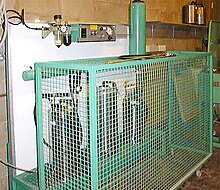The International Pesticide Application Research Consortium (IPARC), previously the International Pesticide Application Research Centre and before that the Overseas Spray Machinery Centre (OSMC), has focused on pesticide application methods appropriate for smallholder farmers since 1955. It is now a research and training group whose purpose is to promote practical and cost-effective techniques, wherever possible reducing the use of chemical pesticides, as part of Integrated Pest Management (IPM). IPARC has been an integral part of pesticide research and teaching at Silwood Park [1] and has specialised in the needs of small-holder farmers, application techniques for migrant pests and control of disease vectors. IPARC is a World Health Organization (WHO) collaborating centre.
Objectives

Besides teaching at postgraduate level and carrying out bespoke training, staff carry-out consultancy work for international organisations and commercial companies. Core expertise includes:
- Long-standing knowledge base on selection and use of sprayers appropriate for the developing world and seeing pesticide application as part of Integrated Pest Management (IPM). [2] [3]
- Pinpointing the target for control techniques: and bridging the gap between laboratory and field via appropriate formulation and application; this has proved especially valuable in the development of biological pesticides (e.g. participation in LUBILOSA [4]).
- Making application technology more accurate - research on development of nozzles, etc. [5]
- Ensuring quality of equipment - standards setting for application equipment and sprayer testing to ensure users get value for money. [6] [7] [8]
- IPARC’s activities are endorsed by the WHO Pesticide Evaluation Scheme (WHOPES) and they include evaluation of application equipment (e.g. compression sprayers) used for mosquito control. [9]
- Participatory training of farmers and trainers; providing manuals & books to assist in IPM training world-wide. [10]
See also
References
- ^ Matthews G A, Pesticide Research at Silwood Park. IPARC, Imperial College, UK.
- ^ Matthews GA, Bateman R, Miller P (2014) Pesticide Application Methods 4th Edition Wiley, Chichester, UK 517 pp.
- ^ Jessop NH, Awudzi G, Bateman RP (2010). How best to spray cocoa with motorised mistblowers? Aspects of Applied Biology, 99: 191-196.
- ^ Bateman, R.P. (1997) Methods of application of microbial pesticide formulations for the control of grasshoppers and locusts. Memoirs of the Entomological Society of Canada, 171: 67-79
- ^ Bateman, R. (2004) The use of narrow-angle cone nozzles to spray cocoa pods and other slender biological targets. Crop Protection, 23: 989-999
- ^ Matthews, G.A. and Thornhill E.W. (1994) Pesticide Application Equipment for use in Agriculture. FAO, Rome
- ^ Doble, S.J., Matthews, G.A., Rutherford, I. & Southcombe, E.S.E. (1985) A system for classifying hydraulic nozzle and other atomisers into categories of spray quality. Proc. for BCPC Conference, p. 1125-1133.
- ^ O’Sullivan C M, C R Tuck, M C Butler Ellis, P C H Miller, R Bateman (2010). An alternative surfactant to nonyl phenol ethoxylates for spray application research. Aspects of Applied Biology, 99: 311-316
- ^ Matthews, G A. (2011) Integrated Vector Management. Wiley-Blackwell
- ^ Bateman R (2010) Pesticide Use in Cocoa: A Guide for Trainers, Administrative and Research Staff. 2nd Edition. International Cocoa Organisation. 70 pp. available on http://www.icco.org/sps
